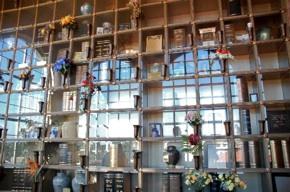For a society of iPod shufflin’, Web surfin’, channel flippin’, Facebook friendin’ individuals, the annual Garden of Memory is an excellent idea. Every summer solstice since 1995, Sarah Cahill and New Music Bay Area present “a columbarium walk-through event at the Chapel of the Chimes in Oakland.” (A columbarium is a place for storage of urns containing the ashes of the cremated deceased.) On Monday, almost 40 different musical acts performed in various chambers of this grand but eerie labyrinth of tombs and urns, while patrons are free to wander in and out as they please.
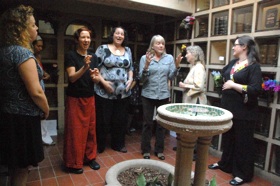
Photos by Hadas Moalem
With options beckoning from all directions, it’s difficult to stay in one place. At a conventional sit-down concert the audience is forced to take a seat, shut up, wait for the end, and leave; only occasionally do people walk out. Here, though, coming and going is the norm; with each show, a revolving door of musical wanderers lost in a maze of unusual sounds. While taking the time from our busy lives to stop and listen is the rightly idealized Zen cliché, it’s refreshing to also participate in an event that glorifies the overflowing wealth of stimuli choices and short attention span of early 21st-century culture.
A map denoted the locations of the various performers, but I often lost my sense of direction entirely. I preferred to explore by ear rather than moseying around with my nose buried in a map like a tourist in a Rome. Acoustically isolated by the marble walls, the sounds of miniconcerts lured listeners in or crept up and jumped on them as they turned the corners. My meandering led me to find a few gems tucked among the book-shaped urns and brass drawers.
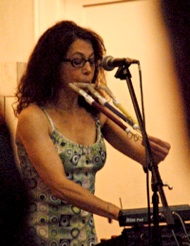
The Impermanent Ensemble, an all-woman vocal group crowded into a room scarcely bigger than a closet, mixed flowing melodies with speech and orally produced sound effects, as well as body gestures. Tucked
away in this tiny room, they sang for an audience that fluctuated between five and 10 people. No more could fit.
One of the headliner names in the event, Amy X Neuburg, performed in a chamber more reminiscent of a concert hall. Out of her toolbox she produced a variety of instruments: a three-pronged plastic whistle, a handmade electronic blip-o-box with a proximity-sensitive antenna, and a variety of electronic looping, reverb, and delay devices. Neuburg controls these unusual instruments with great dexterity, just as a well-practiced violinist controls his or her violin. She combines all this with alien-sounding vocal effects to produce a music that is unabashedly silly, beautiful, fun, and interesting.
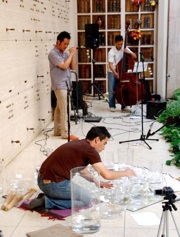
Another well-known name in the Bay Area’s new-music scene is Paul Dresher, assisted on Monday by percussionist Joel Davel. Dresher brought his 20-plus-foot-long metallic stringed instrument that features a rotating element somewhat like a lathe. Hooked up to a large touch-screen resting on a heavy-duty music stand, he produced all kinds of distorted noises, underpinned by a vaguely grooving beat. This was
constructed by a calmer section that featured upended pendulums — 3- to 4-foot-tall, metronomelike contraptions consisting of metal balls inside resonant wood boxes.
Elsewhere, in a marble hall called the Chapel of Tenderness, Adam Fong, Ken Ueno, and Edward Schocker performed a trio of vocals, with double bass and water-filled glasses that shattered at one point (probably due to both the sound waves and the percussive strikes). Next door, an ensemble by the name of Dynosaur consisted of tuba (played casually, with legs crossed), an unidentified mechanical thingamajig (played by a woman who seemed totally engrossed by it), and an old man frantically rummaging through a suitcase and tooting on whatever he could dig up — plastic nozzles, trumpet mutes, whistles, what-not. Together they produced an absolute din that, despite making little (if any) conventional sense, exuded an intense musicality in its noise, perhaps enhanced by the theatricality of the operation.
Bombardment of the Senses
It would be futile for anyone to try to experience, let alone describe, every single endeavor in the four-hour event. I could only handle it for two hours — the ears and brain need time to digest. The event was well-attended and often felt more like an evening stroll through a shopping mall or an amusement park rather than a mausoleum visit or a classical/contemporary concert. The vibe was festive, with patrons unafraid to make comments, while still listening respectfully. Plenty of children were present, though frankly many of them, in their honesty unencumbered by social niceties, could be seen covering their ears with their hands.
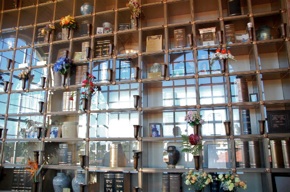
One overarching feature of practically all the presentations I witnessed was the lack of sheet music. Nary could a printed staff or a clef be spied, though some players used descriptive flash cards, scribbled maps, or other visual cues. As a whole, the collage of loosely structured improvisations collectively formed one gigantic, interactive composition. Whether playing their hearts out or playing their brains out, or merely intoning drones with minimal variations, they set the necropolis abuzz like a giant beehive.
The Chapel of the Chimes is a strange venue, built in 1928 and designed by Julia Morgan (1872-1957), whose most renowned project is Hearst Castle in San Simeon, Calif., which was continually under construction between 1919 and the 1940s and today stands unfinished. In the Chapel of the Chimes she reiterated motifs familiar from San Simeon, including Gothic arches, Moorish courtyards, and elements of
East Asian design. Narrow winding staircases, rooms that vary from cozy coves to spacious airy chambers, disorienting corridors, and inconsistent rooftop natural lighting — all combine to create an unsettling, confusing, yet reverential indoor experience.
The denizens of this necropolis are anything but resting in peace every time the summer solstice concert rolls around. Yet far from desecrating the holiness of the site, the concert becomes a celebration of life — life that doesn’t always make sense or yield pleasing expected results, but that churns through time. Most classical concerts are musical mausoleums honoring the great composers: Bach, Mozart, Beethoven, Brahms, and so on. Yet in this literal mausoleum the music was ironically alive — being born in front of our ears, surrounded by death.

